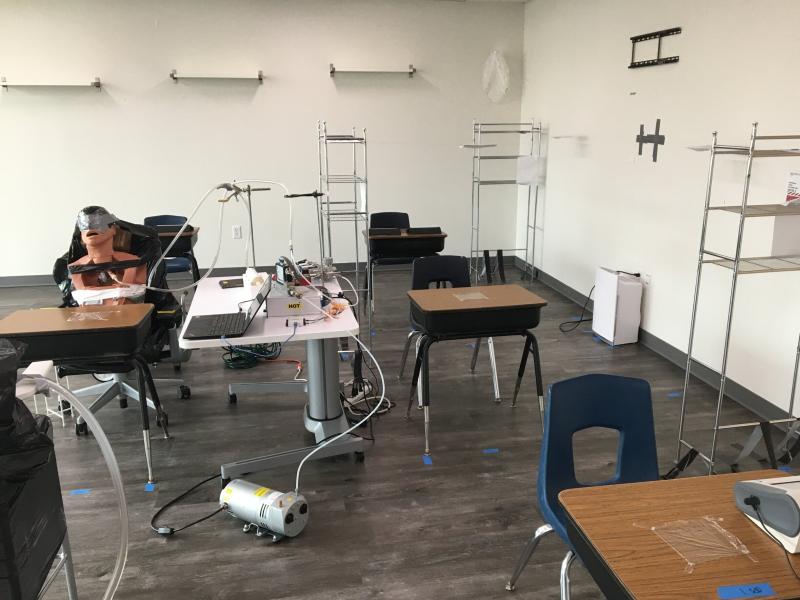Before the COVID-19 pandemic, wellness company Delos began examining indoor air quality at a number of building types—a subject that became increasingly relevant as the outbreak dragged on.
The research, in fact, goes back about a decade, said Peter Scialla, president and COO at Delos, and was inspired by how the green building movement promoted the health of the environment as it pertains to energy usage and carbon footprints. “But we felt, as it pertained to the sustainability narrative more broadly, that there was a real vacuum in thought back then, and so much focus on how buildings affect environmental health—but really, no focus on how buildings affect the health of the people inside,” he said.
The pandemic, Scialla continued, illuminated the importance of clean indoor air. “We know that enveloped viruses are transmitted through the air through aerosolized particles,” he said. The team sought to find an indoor air purification solution that was less expensive and less labor-intensive than updating a building’s heating, ventilation and air conditioning systems, which was the traditional approach.
The Study
The company partnered with the Mayo Clinic and the University of Minnesota for a study on how standalone portable air purification units, when supplementing an HVAC filtration system, can affect the way airborne particles spread throughout a room. The study also examined how these particles concentrate in the air and how they land on different surfaces.
To conduct the study, Delos hooked up a breathing simulator to a mannequin in a model classroom. “What the simulator did is mimic how you or I breathe,” said Zachary C. Pope, a physiologist in the Well Living Lab, a collaboration between Delos and the Mayo Clinic. As the simulator “breathed,” the team could monitor how particles came out of the mannequin’s mouth during exhalation and how they moved through the surrounding space.

Key Findings
The study found that air changes per hour—the amount of air added to or removed from a room over a one-hour time period—doubled when three portable air purification units were used to supplement the room's HVAC system. Supplementing an HVAC system with air purification units resulted in up to five times lower particle concentration in some locations, improving air quality throughout the classroom, not just near the unit. (“You can't move an HVAC system, obviously,” Pope said.) Furthermore, infectious particles accumulated on surfaces 33 percent slower when portable air purifiers were used compared with using an HVAC system alone.
Perhaps most importantly for businesses already feeling the pinch of an economic downturn and a labor crisis, the study did not find a need for a newly designed project, new construction or a gut renovation. The units can sit on a floor or be hung from a wall. “Wall-mounted air purification units are very easy to install,” Pope said. “You're not talking about a lot of labor, you're not talking about breaking sheetrock, you're not talking about redesigning or re-engineering HVAC configurations and trying to do things that are complicated and expensive.”
The air purifiers can also help take the pressure off a building’s existing ventilation networks. “HVAC systems can often not handle the rigor of putting enhanced filtration inside the [unit] itself,” Pope said. “It creates differences in pressure that some HVAC units can't handle, and it can ultimately lead to a case where your HVAC system ultimately wears itself out.”
Air Purifiers in Hospitality
Scialla said the study’s findings are significant because they “increase conviction” in terms of what can be done to address indoor air quality and other wellness categories, giving building owners and management companies more options. “This is applicable to all space types, no matter how old a building is, no matter how ventilated a building may be,” he said. “It gives us more conviction to make sure that the addressable market here is not just new construction and design but also hotels that are occupied and running and have been built for many, many years, [or even] decades.”
Portable air purification units, especially ones mounted to a wall, offer more than one source within a space that is actively cleaning and recirculating air. “That's not something that you get with the typical packaged terminal air conditioners that you see in a lot of hotel rooms,” Pope said, noting that many hotels only bring in fresh air through one wall. Furthermore, he said, many packaged terminal air conditioning units are not equipped with filtration systems. “And if they are, it's not the type of filtration that you'd find in what is a very cost-effective solution in a portable air filtration unit.”
Scialla noted that the study’s findings could have a substantial impact on buildings with limited ventilation options—such as hotel guestrooms and public spaces. “It’s certainly harder to open windows in hotel environments,” he noted. Delos is now extending its simulations and studies into other environments, including hotels.
